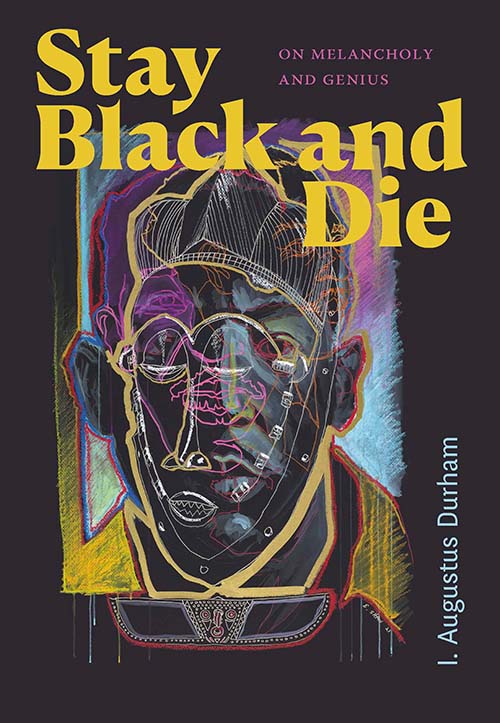Original story written by Sean McNeely and published on A&S News.
I. Augustus Durham’s exploration of Blackness blends personal history, academic inquiry and his deep commitment to understanding its influence on culture, identity and creativity.
“The bulk of my work is thinking about the presence and meaning of Blackness in the modern world,” says Durham, who joined U of T last summer as an assistant professor in the Faculty of Arts & Science’s Department of English.
“Some people would understand that to be metaphysics or ontology. Some would understand it to be history. But I'm tracing all of those fault lines to try to understand how it emerges in the modern world as an idea.”
Related to his research, Durham also explored Blackness in his 2023 book, Stay Black and Die: On Melancholy and Genius.

In this book, Durham examines the relationship between melancholy — particular to experiences of race and identity — and genius in Black letters, culture and history from the 19th century to the present.
Drawing on psychoanalysis, the study of feelings and emotions (affect theory) and Black studies, Durham focuses on the role of the feminine, especially Black mothers, in shaping the creative or intellectual achievements of Black men, and how this connection influences ideas about race, gender and genius.
He looks at the works of abolitionist and orator Frederick Douglass; writer and literary critic Ralph Ellison; science fiction writer Octavia E. Butler; and singers Marvin Gaye and Kendrick Lamar, to show how Black cultural practices and artistic expression reveal the lost mother through performance.
“That performance of genius, whether consciously and unconsciously, is often them channeling the mother that they have presumably ‘lost,’” says Durham. “These experiences of loss, in whatever form they take, are oftentimes reimagined in the work, even if the artists are not aware of it.”
Examining each artist’s life in great detail, Durham seeks out small events that had a tangible impact on their lives and creativity.
The narratives we crafted about them may lean to be overly positive in such a way that it almost removes the fact of them being flawed, as we all are. There's a narrative I've been taught, and then there's a narrative that I ended up teaching myself.
“I work at the level of the granular — when we take these big ideas and get to something like, what did your mother do or provide to you when you were a child?” he asks. “In the case of Ralph Ellison, it’s his mother giving him a typewriter one year for Christmas. These small acts, or what we might read as small acts, actually become the germ of what these artists will eventually produce.”
For Durham, writing this book evoked a spectrum of emotions.
“It was a feeling of ambivalence because in a lot of ways, writing the book was an endeavour in both learning and unlearning because the people that I wrote about are the people I read in school and listened to from early childhood,” he says.
“The narratives we crafted about them may lean to be overly positive in such a way that it almost removes the fact of them being flawed, as we all are. There's a narrative I've been taught, and then there's a narrative that I ended up teaching myself.”

While writing Stay Black and Die Durham was also struck by his personal connections to the artists.
“For example, although we know him as Frederick Douglass, his birth name was Frederick Augustus Washington Bailey. So the fact he and I have the same middle name is uncanny,” says Durham. “And when I moved to New York, I was living in Harlem and not far from where I lived was the church where Douglass was married.”
When Durham was living in Harlem, he lived on the fourth floor of a building, and above him was an apartment where a couple was singing opera. “In the book’s chapter about Ralph Ellison, I talked about a short essay he wrote called “Living with Music” that’s about him living under a woman who sings opera.”
In addition to his writing and research, Durham’s current courses further explore Blackness — courses like Tracking the Sound where students listen to various Black film soundtracks, discussing the artists, music and the cultural impact and significance of these arrangements.
“I give them a topic like mass incarceration or climate change, then I have them produce a playlist for a final project, almost as if to soundtrack an idea. I try to give students things where we go from that kind of broad theoretical framework to something that's pragmatic, and perhaps usable,” he says.
Durham’s other course, American Literature 1900 to Present, looks at literature from a fascinating angle — the presence and meaning of the colour blue.
Utilizing various forms of media, including film, sound, television, and texts, this class looks at the cultural phenomenon of the colour blue and its presence in music, its relation to mood and feelings, as well as its connection to broader subjects like race.
“I have them do a final project where they educate us about a colour and as a kind of mimicry of the general premise of the course,” says Durham.
Now we're seeing the repealing of programs that were meant to ‘level the playing field.’ Books being banned, oftentimes books by Black authors, and threats to defund organizations and universities are putting America in a peculiar light that it has perhaps always lived under.
Though much of his research and courses focus on literature and culture, Durham sees exploring the presence of Blackness as very timely. “Certainly given the political landscape in the U.S., this is something that’s a relevant conversation,” he says.
“Now we're seeing the repealing of programs that were meant to ‘level the playing field.’ Books being banned, oftentimes books by Black authors, and threats to defund organizations and universities are putting America in a peculiar light that it has perhaps always lived under.”
What makes Durham’s research so absorbing is that the presence of Blackness, though often difficult to quantify, is undeniable.
“Some of the difficulties about notions of the presence of Blackness is that even when it's not there, it's always there, especially in the modern world. It doesn't have to be present in a body or in an artifact, but it can still have some kind of influence.”


